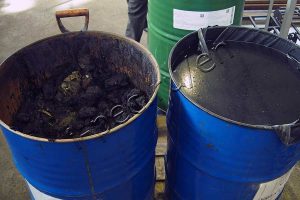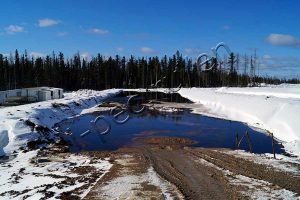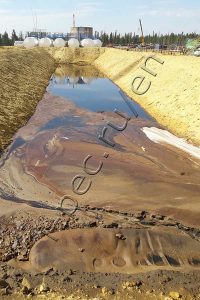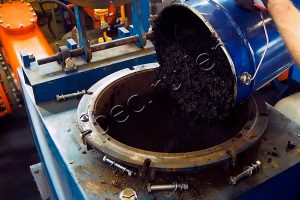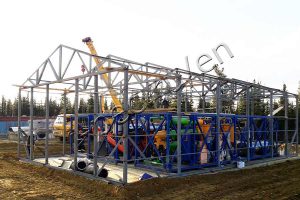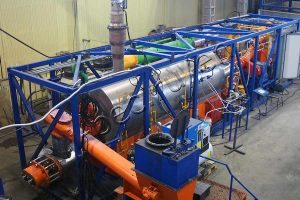The oil industry challenge is oil sludge treatment, which is formed as a result of almost any operation involving the handling of oil products and oil. Oil sludge is a stable multicomponent physico-chemical mixture of oil products, water and mechanical impurities (clay, sand, corrosion products of tanks, sludge).
By the method of formation, several groups of oil sludge are distinguished:
- bottom – the result of the interaction of oil spills and the water bottom;
- reservoir – the result of physico-chemical interaction of petroleum products with moisture, air, mechanical impurities and the walls of storage/transportation tanks;
- ground – formed during accidental and emergency spills of oil products into the soil.
Despite the active development of environmental technologies, today oil sludge dumping in special oil pits, containment pond, and sludge beds at refineries is widespread. Millions of tons of toxic waste are real environmental threat and constant source of contamination of soil, ground water and air. It is worth taking into account that there is a possibility of an involuntary shutdown of oil refineries due to overfill of oil sludge storages after cleaning the tanks of oil product residues. At the same time, the costly construction of new oil sludge pits will only delay the solution of the problem for a later date.
The difficulties of oil sludge treatment are determined largely by the heterogeneity and multicomponent nature of the mixtures. When determining the hazard class of oil sludge, many toxic and carcinogenic elements, such as heavy metal ions, polyaromatic and sulfur compounds, light aromatic fractions, naphthenic hydrocarbons, mineral and organic salts, surfactants, etc. are not taken into account.
Consider tank oil sludge as an example. In the process of interaction between the components of oil sludge with each other and the material of the walls of the tank, resinous substances and rust are formed as a result of the oxidation of oil products and metals. Water-oil emulsions and mineral dispersions are formed due to moisture and mechanical impurities entering the reservoir. Due to the uniqueness of environmental conditions and the period of generation of sludge in nature, it is impossible to meet two sludge of the same composition and physicochemical parameters.
Studies have shown that the content of various components in oil sludge varies over a wide range: oil products up to 60%, water – 90%, solid impurities – 90%. After all the old oil sludge as a result of long-term storage is stratified into fractions with properties characteristic for each of them, which in turn affects the adoption of treatment technology.
In addition to preventing negative environmental impacts, the processing of oil sludge can bring significant benefits to the enterprise: the quotation is determined by the quality and cost of refined products. For a ton of utilized waste, the profit is achieved by the sale of recovered boiler fuel, the output of which, on average, is 70% of raw materials. Therefore, it is very important to choose an environmentally friendly and cost-effective treatment technology of oil sludge.
Oil Sludge Recovery Methods
Existing oil waste management methods are presented in the table.
| The method of processing oil sludge | Advantages | Disadvantages |
| Thermal |
|
In the case of incineration, the need for a complex and expensive flue gas purification system, transportation to the place of incineration. |
| Biological |
|
Strict requirements for operating conditions. Inability to use in conditions of low temperatures, or with deep soil contamination. |
| Mechanical |
|
Expensive, 100% imported equipment that requires qualified service. |
| Chemical | obtaining building materials. | The cost of reagents (polyurethanes, resins, water glass, cement), the environmental load of the sludge processing process is quite large. |
| Physicochemical | reducing the load on the environment due to the neutralization of sludge and its transfer to a immobile form. | In fact, the waste remains in place, sludge pits are not eliminated. |
Today, there is an effective patented domestic technology for the oil sludge treatment – low-temperature continuous pyrolysis based on Thermal Decomposition Plants (TDP-2) manufactured by IPEC (Safe Technologies Inc.).
Pyrolysis: Process Steps of Oil Sludge processing at TDP-2
The operation of the TDP-2 unit is based on heating oil-containing wastes under conditions of oxygen deficiency, followed by separation, condensation and purification of the resulting product. Raw materials are continuously fed into the pyrolysis chamber, where they are dried (in the lower part of the chamber) and pyrolyzed (in the middle and upper part of the chamber). With a high water cut of oil sludge, a sequential tandem of two reactors is provided: drying and pyrolysis.
The gas-vapor mixture from the reactor is sent to the pyrolysis gas filter and then enters the condensation system:
-
- Pyrolysis gas is purified from acidic compounds by passing through an alkaline solution and fed to auxiliary burner devices as fuel.
- The liquid pyrolysis fuel obtained in the condensation process is discharged into the storage tank, from where it is pumped into the fuel tank or into the finished goods warehouse. At the request of the Customer, an additional rectification module can be installed to increase the yield of light oil products in the resulting fuel up to 90%: gasoline and diesel fuel.
- The unloading of dry residue (process char) occurs automatically using a screw. Process char is a certified product that can be used in the roads and slopes furniture, in the reclamation of sludge pits, landfills and open cast mines, and used as an anti-icing agent.
Thus, due to the upgrade of the TDP with additional process units, oil sludge can be disposed of taking into account the wide variation in the composition and parameters of the incoming feedstock. Equipment needed for the processing of complex oilfield waste is also manufactured at IPEC’s production facilities.
The TDP-2 oil sludge recycling unit is the best way to process such waste both from an environmental point of view and due to economic benefits. The economic benefit is due not only to market grade outputs, but also to relatively low energy consumption (up to 60 kW per ton of waste), as well as the minimal need for external fuel due to the production of own pyrolysis gas and boiler fuel. An automated process control system provides constant monitoring of all parameters, the process is controlled automatically and manually from the operator’s panel.
The pyrolysis equipment TDP-2 is leak-tight, including the solid residue unloading system, therefore its environmental impact is minimal, which is confirmed by the positive conclusion of Federal Service for Supervision of Natural Resource Usage. Gas emissions into the atmosphere are minimal and comply with environmental.
High performance is achieved due to the continuous cycle of oil sludge processing regardless of its composition. An improved screw system has been developed that promotes more efficient mixing of raw materials in the reactor and, as a result, ensures uniform heat transfer over the entire surface of the reactor. Due to this design modification, the performance of the oil sludge treatment unit is significantly increased while maintaining the dimensions of a standard 40 ft. container.
Today IPEC pyrolysis plants are operated at such industrial facilities as PJSC NGK Slavneft (Kuyumbinskoye field, Krasnoyarsk Territory), PJSC Lukoil (Komi Republic), Commercial Sea Port of Ust-Luga (Leningrad Region), JSC Gazpromneft-Noyabrskneftegaz (Vyngapurovskoye field, YaNAO), Gazprom Burenie (Thermokarstovoye field, YaNAO), Messoyakhaneftegas JSC (Messoyakhskoye field, YaNAO) and others. The leaders in the oil and gas and petrochemical industry have confidence in IPEC when choosing technology for oil sludge recovery.
The production facilities and the quality of the IPEC equipment complies with international standards CE, ASME, EAC, which is confirmed by the relevant certificates.
Find more about TDP-2 model range in the catalog of Thermal Decomposition Plants.
The article ‘Oil Sludge Recovery: TDP-2 Treatment Technologies’ was published in the journal “Ecoeng” issue No. 19, 2019.
When using the material/any part of it, a reference to authorship and a website (www.i-pec.ru/en) is required.

